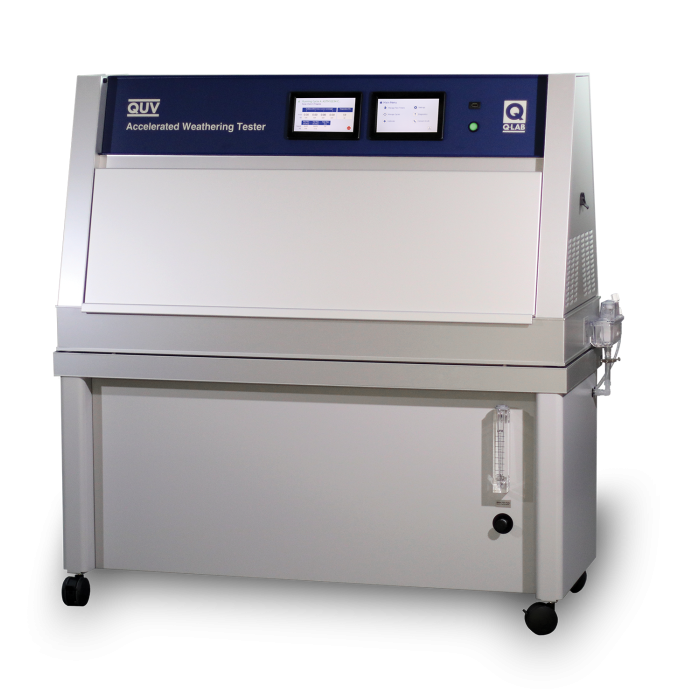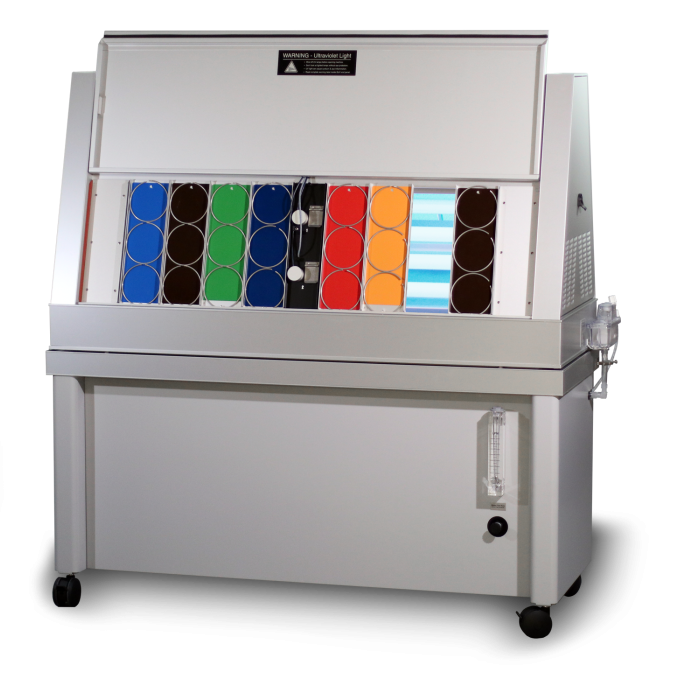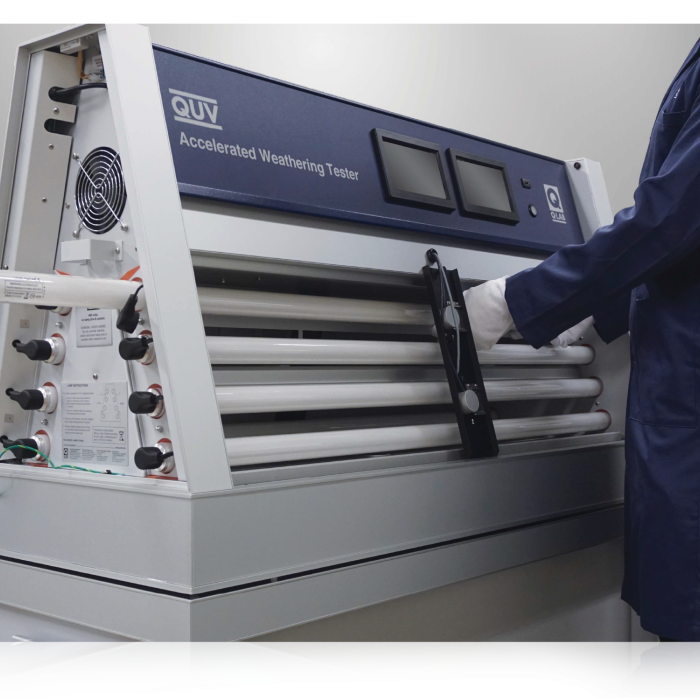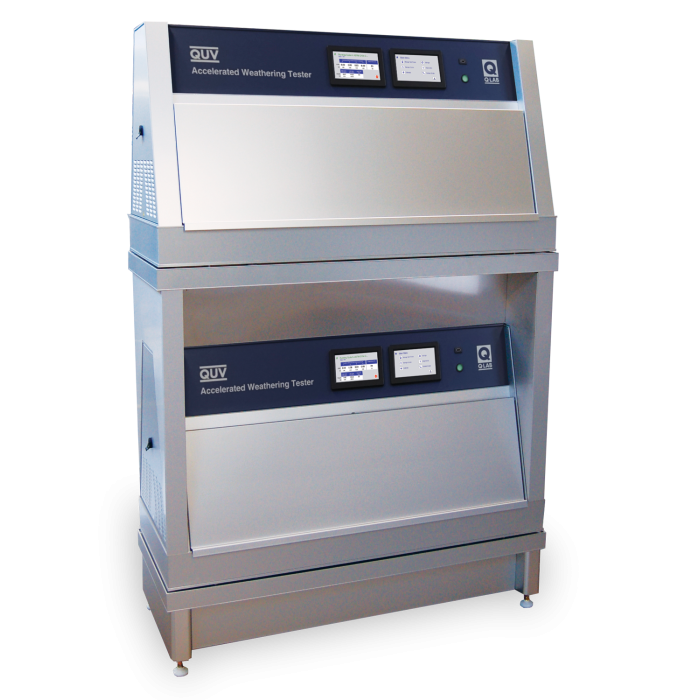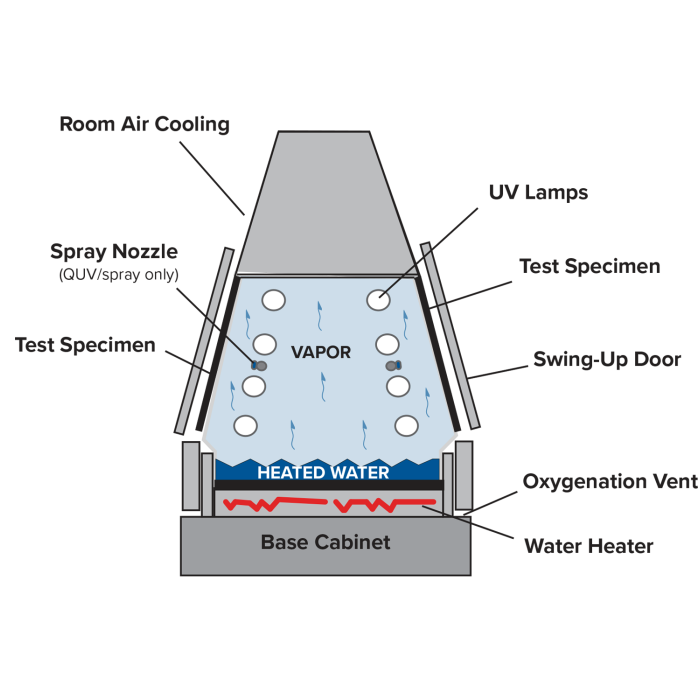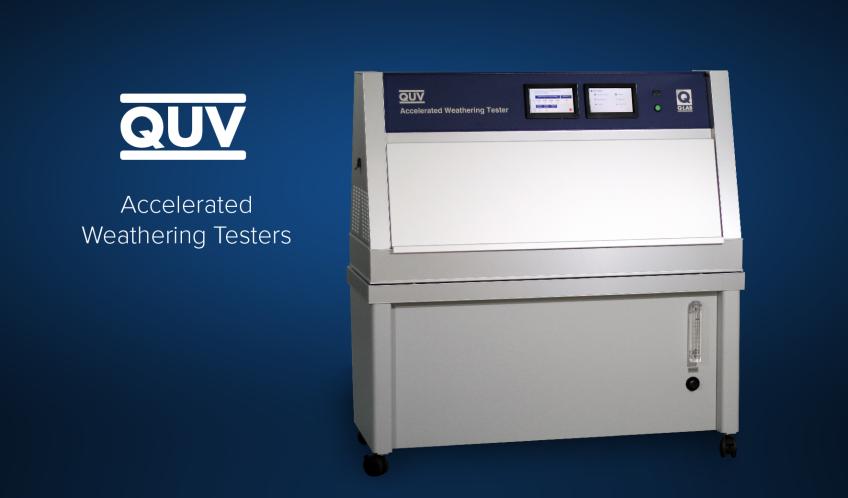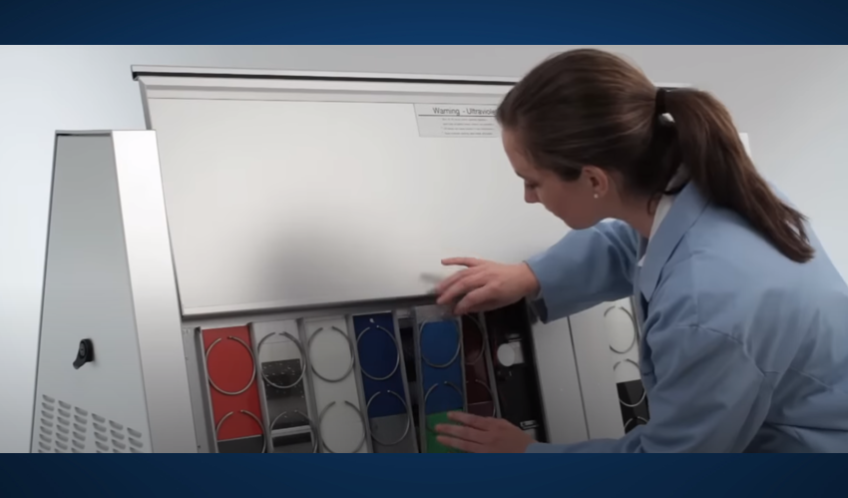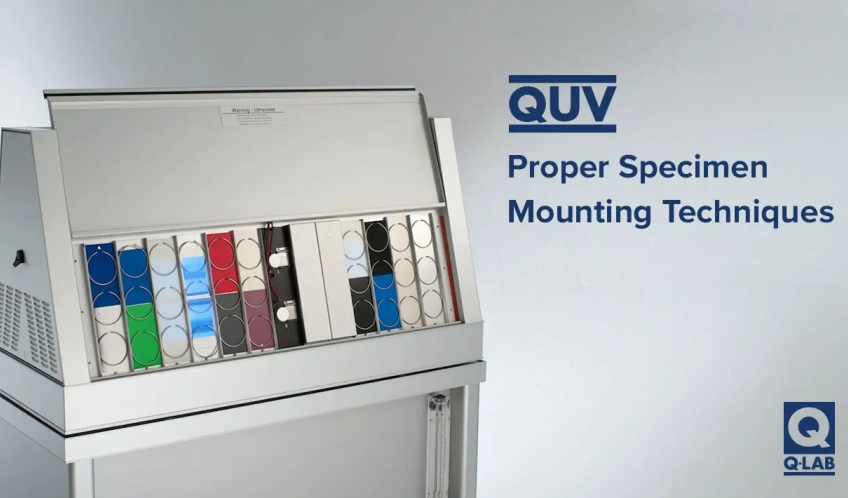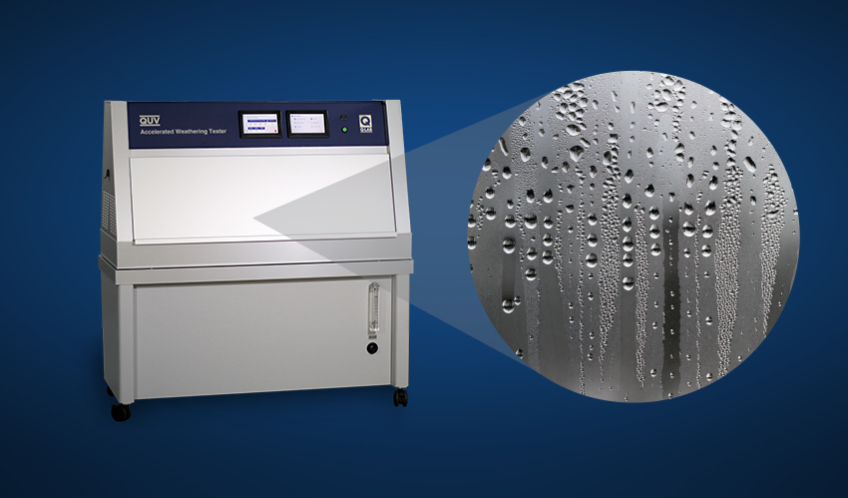QUV
Accelerated Weathering Tester
The QUV accelerated weathering tester reproduces the damage caused by natural sunlight, rain, and dew. In a few days or weeks, the QUV tester can reproduce the damage that occurs over months or years outdoors.
To simulate outdoor weathering, the QUV accelerated weathering tester exposes materials to alternating cycles of ultraviolet (UV) light and moisture at controlled, elevated temperatures. It simulates the effects of natural sunlight and artificial irradiance using special fluorescent UV lamps in the UVA, UVB, and UVC portions of the spectrum. It simulates dew and rain with condensing humidity and/or water spray.
The QUV accelerated weathering tester is the simplest, most reliable, and easiest-to-use weathering tester available. QUV and Q-SUN xenon arc testers are complimentary test types - see QUV and Q-SUN: A Comparison for further information. With thousands of testers in use worldwide, it is the world's most widely-used weathering tester.
The World's Most Widely Used Weathering Tester™
Test plastics, coatings, and other materials for durability when exposed to outdoor sunlight, heat, and water
UV light is responsible for almost all photodegradation of durable materials exposed outdoors. The QUV tester’s fluorescent lamps simulate the critical short-wave UV region of the solar spectrum and realistically reproduce the physical property damage caused by sunlight. Types of damage include color change, gloss loss, chalking, cracking, crazing, hazing, blistering, embrittlement, strength loss, and oxidation.
Dew, not rain, is responsible for most of the wetness that occurs in outdoor exposure. The QUV test chamber's condensation system realistically simulates dew and accelerates its effect using elevated temperature.
The condensation process automatically purifies the ordinary tap water used in the system. This is because the process of evaporating and condensing the water onto the specimens is actually a distillation process, which removes all impurities. See the QUV Brochure for details.
The QUV tester conveniently accommodates up to 48 specimens (75 × 150 mm) and complies with a wide range of international, national, and industry specifications, ensuring the reliability and reproducibility of your test program. Visit our standards search for more information.
Easy to Use
The QUV tester’s simple, proven design makes it easy to install, easy to use, and almost maintenance-free. The QUV tester is completely automated and can operate continuously, 24 hours per day, 7 days per week. Other features include:
- Remarkably simple user interface in 17 user-selectable languages: English, Spanish, French, German, Italian, Japanese, Chinese, Korean, Czech, Dutch, Polish, Portuguese, Russian, Swedish, Thai, Turkish, Vietnamese
- Built-in Ethernet connection for data logging
- Comprehensive self-diagnostic warnings and service reminders
- Quick and easy calibration with patented AUTOCAL system
- Designed for safety in operation, calibration and maintenance
Affordable
The QUV tester is economical to purchase and to operate. It features low-cost, long-life fluorescent UV lamps and uses ordinary tap water for condensation.
Models (see also Features Tab)
- QUV/basic: UV and condensation (no irradiance control, single touchscreen display)
- QUV/se: UV, condensation, and SOLAR EYE irradiance control
- QUV/spray: UV, condensation, SOLAR EYE irradiance control, and water spray
- QUV/uvc: short-wave UVC light and SOLAR EYE irradiance control
- QUV/cw: cool white visible light, condensation, and SOLAR EYE irradiance control
See QUV Specifications or the Features Tab for comparative capabilities.
Key Documents
- QUV Product Brochure
- QUV Specification Bulletin
- QUV Virtual Simulator
- QUV & Q-SUN: A Comparison
- QUV & Q-SUN Correlation FAQ's
For all QUV documents, browse our full document library. Select documents are also available in multiple languages. Click here to view translated documents.
QUV/se
The most popular QUV model features SOLAR EYE Irradiance Control, for precise maintenance of UV light intensity. The QUV/se tester uses a proven condensation mechanism to simulate outdoor moisture attack.
The SOLAR EYE system is a precision control system that automatically maintains light intensity through a feedback loop. The controller monitors UV intensity and compensates for lamp aging and variability by adjusting power to the lamps. The SOLAR EYE system provides:
- Controlled irradiance
- Longer lamp life
- Faster results
- More reproducible and repeatable testing
- ISO-compliant calibration
For more information on the benefits of the SOLAR EYE irradiance control system, see the QUV Brochure.
QUV/spray
The QUV/spray tester performs all the same functions as a standard QUV/se tester, plus direct water spray. Short periods of spray can be used to create thermal shock. Longer periods of spray can be used to achieve mechanical erosion. The QUV/spray tester can be set to produce UV, spray, condensation, and functions combining UV and water. Purified, deionized water is recommended for all spray applications.
QUV/uvc
UVC light is used widely in ultraviolet germicidal irradiation (UVGI), a technique used to eliminate harmful viruses and bacteria. This short-wavelength, high-energy UVC light can also degrade the materials and surfaces it disinfects. The QUV/uvc model uses UVC lamps to deliver light concentrated at 254 nm to test for material durability against photodegradation effects resulting from exposure to UVC light. The QUV/uvc tester has multiple safety features to prevent stray UVC light from escaping. It is not equipped with condensation or water spray.
QUV/cw
Some industry test methods specify the use of cool white fluorescent lamps for indoor photostability testing. To reproduce these indoor light conditions, the QUV/cw uses ordinary cool white fluorescent lamps. It has a SOLAR EYE irradiance control system that monitors and controls visible light output, rather than UV. See the QUV Cool White Summary for more information.
QUV/basic
This is a simplified version of the QUV tester for laboratories where economy is critical. The QUV/basic tester uses fluorescent UV lamps and a condensation system for moisture simulation. It does not, however, include SOLAR EYE irradiance control. Consequently, the light intensity cannot be adjusted or calibrated. This means the QUV/basic tester cannot be used for high irradiance testing. In addition, periodic lamp replacement and repositioning is required.
Q-Lab recommends the QUV/basic tester only for comparative exposures where the test specimens and the control specimens are exposed at the same time, in the same tester.
Temperature Monitoring & Control
All QUV accelerated weathering testers precisely control temperature to enhance accuracy and accelerate test results. Although temperature does not normally affect primary photochemical reactions, it does affect the rate of any subsequent reactions. Therefore, the QUV tester’s ability to control temperature is essential during UV exposure.
Versatile Specimen Mounting
Standard specimen holders easily adjust for any thickness up to 20 mm (3/4 in) and allow fast, snap-action specimen mounting. Retaining rings provide positive hold-down and do not require that test specimens be cut to close tolerance. In addition, custom holders are available for mounting various products, such as lenses, larger specimens, and 3D components. See the Accessories tab or the QUV Specimen Mounting Bulletin for more information.
SOLAR EYE Irradiance Control
The SOLAR EYE irradiance control system constantly monitors and controls lamp output. This assures precise light exposure and maximizes reproducibility of test results.
Software & Operations
The QUV accelerated weathering tester’s displays are designed to be both functional and easy-to-use. QUV testers feature dual, full-color touchscreen displays (except QUV/basic, which has a single touchscreen display) and can be programmed in 17 user-selectable languages (English, French, Spanish, Italian, German, Chinese, Korean, Japanese, Czech, Dutch, Polish, Portuguese, Russian, Swedish, Thai, Turkish, and Vietnamese). This system includes complete self-diagnostic error checking, constantly monitoring the status and performance of all systems. It also displays tester error messages and routine service reminders as needed. The multicolor LED status indicator light updates users on the tester’s operational state at a glance.
An external USB port on every QUV tester allows users to perform software upgrades quickly to address key performance issues. For quality systems that require documented proof of test conditions, this USB port can also be used to download tester performance history with Q-Lab's VIRTUAL STRIPCHART software. Data from the USB export can be emailed directly to Q-Lab's technical support desk for expert troubleshooting and diagnostics.
QUV Lamps
Fluorescent UV lamps are inherently more stable than other types of lamps, including xenon arc lamps. The spectral irradiance (or spectral power distribution, SPD) does not change with lamp aging, even up to 8,000 hours. This gives more reproducible test results, fewer lamp changes, and lower operational costs.
Q-Lab produces more UV lamps than the rest of the weathering industry combined. Q-Lab's lamps are specially engineered to our own proprietary specifications, based on our 50+ years of experience with fluorescent UV technology. We have the most stringent quality control testing in the industry. The result is that the QUV tester provides the most consistent, stable spectrum, year after year.
Several different types of UV lamps are available for different applications, listed below along with links to their Spectral Irradiance (or Spectral Power Distribution, SPD). See A Choice of Lamps for QUV and the QUV Cool White Summary for more specific application guidelines.
UVA-340
The QUV tester’s UVA-340 lamps give the best simulation of sunlight in the critical short wavelength region from 365 nm down to the solar cut-on of 295 nm. See SPD for QUV UVA-340 and UVA-340+.
UVA-340+
UVA-340+ lamps offer the same spectrum as UVA-340 lamps but provide longer lifetime at high irradiance setpoints. See SPD for QUV UVA-340 and UVA-340+.
UVA-351
The QUV UV tester’s UVA-351 lamps simulate the UV portion of sunlight filtered through window glass. They are most useful for testing interior applications and reproducing polymer damage that can occur in an environment near a window. See SPD for QUV UVA-351.
UVB-313EL
The QUV tester’s UVB-313EL lamps maximize acceleration by utilizing shortwave UV that is more severe than the UV normally found at the earth’s surface. Consequently, these lamps may produce unrealistically severe results for some materials. UVB-313EL lamps are most useful for QC and R&D applications, or for testing very durable materials. See SPD for QUV UVB-313EL.
UVB-313EL+
UVB-313EL+ lamps offer nearly the same spectrum as UVB-313EL lamps, but provide longer lifetime at high irradiance setpoints. See SPD for QUV UVB-313EL+.
UVC-254
UVC lamps deliver high-intensity, monochromatic, shortwave UV light at 254 nm, which is well below the solar cut-on. This wavelength represents the most common type of UVC emission used for disinfection of surfaces exposed to harmful bacteria and viruses. While it can kill these pathogens effectively, UVC light can also cause photodegradation of plastics, coatings, and fabrics. UVC lamps reproduce this damaging irradiance, in order to evaluate durability of materials exposed to UVC light. See SPD for QUV UVC-254.
QFS-40
Also known as FS-40 or F40 UVB, this is the original QUV lamp, with a spectrum most like a UVB-313 lamp. FS-40 lamps are still specified in a few legacy automotive test methods. QFS-40 lamps should only be used in the QUV/basic tester.
Cool White
The QUV UV test chamber’s cool white lamps (used only in model QUV/cw) effectively reproduce and accelerate indoor lighting conditions encountered in office and commercial environments as well as retail display lighting. See SPD for QUV Cool White Lamps.
TUV-421
TUV-421 lamps provide the same excellent shortwave UV match to natural sunlight as UVA-340 lamps, but with the addition of long-wavelength UV and short-wavelength visible light. This helps reproduce color change effects in materials sensitive to longer-wavelength irradiance.
Temperature Calibration
The QUV black panel temperature sensor needs to be calibrated periodically by the user to assure accurate and consistent results. Calibrating the QUV black panel temperature sensor is quick and simple, and is performed with any standard reference thermometer.
Irradiance Calibration
For all models except QUV/basic, the QUV SOLAR EYE irradiance sensors need to be calibrated periodically by the user to assure accurate and consistent results. Calibrating the QUV tester is simple using the Universal Calibrator system’s UC10 calibration radiometer, and takes only a few minutes. Three models of UC10 irradiance smart sensors are available:
- UC10/UV - for use with UVA-340, UVA-351, UVB-313, and TUV-421 lamps (plus and non-plus versions)
- UC10/UVC – for use only with UVC-254 lamps
- UC10/CW - for use only with Cool White lamps
ISO 17025 Accredited Recalibration
Calibration of UC10 radiometers needs to be performed annually. UC10 radiometers were designed to be disposable and cost-efficient, and can either be replaced annually with a freshly-calibrated sensor or returned to Q-Lab once per year for an inexpensive recalibration. See our Recalibration Return Procedure.
Q-Lab's calibration labs in the United States, Germany, United Kingdom, and China are ISO 17025 accredited by the American Association of Laboratory Accreditation (A2LA) to perform calibrations of UC sensors. Calibrations are traceable to the United States' National Institute of Standards and Technology (NIST).
Versatile Specimen Mounting
The QUV accelerated weathering tester can be used to test a variety of specimens. Coatings, plastics, and films are easily accommodated in the QUV tester using standard flat panel specimen holders. Standard specimen holders adjust for any thickness up to 20 mm (3/4 in) and allow fast, snap-action specimen mounting. Retaining rings provide positive hold-down and do not require that test specimens be cut to close tolerance.
Other specimens can be mounted using specialty holders. Q-Lab also offers custom specimen holders for unique needs. All of Q-Lab’s panel holders are designed to meet the requirements of ASTM G154 and other international standards.
The QUV chamber can accommodate a variety of sample types, but three principles should be considered when mounting odd-shaped specimens:
- To ensure uniformity of UV exposure, the surface of the test specimen should be in the standard sample plane, 50 mm (2 in) from the lamps.
- The specimens and their holders must seal off the side of the QUV tester to prevent vapor from escaping from the chamber.
- Specimens should have good thermal contact with any backer present, since room air cooling causes condensation. Highly insulating samples thicker than 6 mm (0.24 in) may require special attention.
In addition, custom holders are available for mounting various products, such as lenses, larger specimens, and 3D components. Bottle holders, textile holders, and special mountings are also available. See our guide to QUV Specimen Mounting for more detailed information.
Water Repurification System
To significantly reduce the cost of running the QUV tester’s optional water spray system, Q-Lab offers a Water Repurification System that reuses the water that normally would go down the drain. This system can save over 1,000 liters of expensive, purified water per day in a test cycle that calls for several hours of water spray, and can pay for itself in a matter of months.
Unlike competing systems that simply recirculate dirty water, Q-Lab's repurification system repurifies water in addition to conserving it. Major components include a water reservoir, a pump, a flow adjustment valve, a repurification cartridge, and a Total Dissolved Solids (TDS) purity monitor.
Space Saver Frame
In labs where space is a premium, QUV testers can be stacked two-high with Space Saver Frames. The QUV tester is designed with doors that swing up and out of the way for easy access to the chamber. QUV space saver frames maintain the benefits of this feature by allowing sufficient clearance between the upper and lower units. Frames are available in two different models for compatibility with all new and existing QUV testers.
Insulated and Uninsulated Black Panels
Uninsulated black panel thermometers are standard for most UV fluorescent testing, but insulated black panel thermometers may be more suitable for testing insulating and three-dimensional specimens. The QUV tester can be equipped with either type.
More QUV Resources At Your Fingertips
Document Library
Browse Q-Lab’s extensive library of weathering testing literature and technical content.
Education
Check out blogs, case studies, articles, and webinars to build your knowledge of weathering testing.
Standards
Review setup and performance information on key international and OEM test standards from ASTM, ISO, SAE, JIS, GB, and more.
